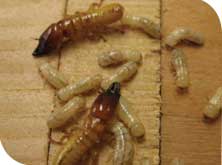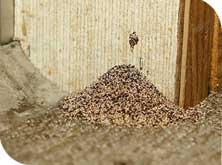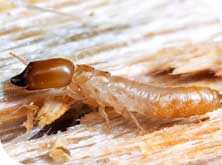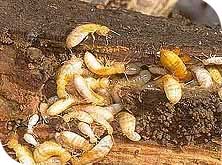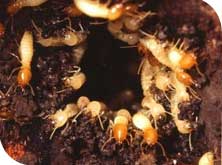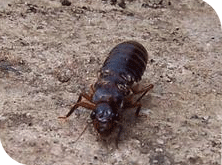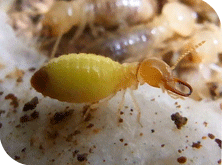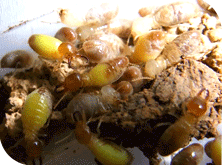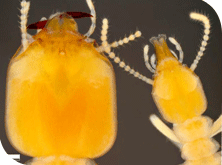Termites
Termites are social insects living in colonies comprised of a king and a queen (wingless adults or nymphs, depending on the species), and soldiers . The king and queen perform the reproductive functions of the colony, while the workers carry on all aspects of colony maintenance. The soldiers defend the colony. These individuals, separated by divisions of labour, are referred to as castes Termites feed on wood or wood products, and their digestive tracts contain microorganisms which enable them to convert the cellulose in wood into usable food.
Termites vs Ants

- Termites are often confused with ants
- The termite has straight beadlike antennae, while those of ants are elbowed
- The abdomen of the termite is broadly joined to the thorax (no waist), while the ant’s thorax and abdomen are joined by a narrow pedicel (wasp waist)
- Termite wings, both the front and the hindwings, are of equal size. The anterior wings of the ant are considerably larger than the posterior wings
Common Termite Pest Species
Drywood Termites
- Drywood termites are social insects that live in colonies in sound, dry wood
- In comparison to other termites, drywood colonies are rather small (a few thousand individuals), and the colony develops slowly
- They neither live in the ground nor maintain contact with the soil, and they do not build mud tubes
- Drywood termites produce dry fecal pellets compared to subterranean termites that produce liquid feces
- Drywood termites tend to feed across wood grain impacting both the soft spring wood and the harder summer growth
- Dead trees, branches, brush and firewood from residential areas are the primary habitat of drywood termites
Dampwood Termites
- Dampwood termites are found only in wood with high moisture content
- Dampwood termites do not usually infest structures because of the low moisture content of wood in structures
- Dampwoods are considered a minor structural pest, but they can do substantial damage if left unchecked
- Dampwood termites produce distinctive fecal pellets that are rounded at both ends, elongate, and lack the clear longitudinal ridges common to drywood termite pellets
- Dampwood fecal pellets are often stuck together along the bottom or sides of the tunnels or may dissolve into a muddy paste
- Infested wood usually shows no external damage because openings in the wood are plugged with fecal material
- They nest in wood buried in the ground, although contact with the ground is not necessary when infested wood is high in moisture
Subterranean and Mound-building Termites
Coptotermes Spp.
- Coptotermes species is one of the most destructive termites in Asia
- Coptotermes spesies alone is responsible for at least 80-90% of damage to human built structures, based on past statistics, and it is the most common termite species in all urban areas
- They have a voracious appetite for anything wood or paper, and may even attack fabric
- Their nests are located deep underground
- They have a large and conspicuous fontanella
- They secrete a white, sticky liquid upon biting, through the fontanelle
Macrotermes Spp.
- The Macrotermes genus are the largest termite species of all
- Most species of Macrotermes build mounds, although there are a few subterranean species
- Macrotermes species are noted for having two sizes of workers and two sizes of solders (major and minor workers and soldiers).
- The unique thing about Macrotermes termites is their fungus cultivation habit
- They have a large and conspicuous fontanella
- They secrete a white, sticky liquid upon biting, through the fontanelle
Globitermes Sulphureus
- Globitermes sulphureus is a species of termite that is very common in present in other areas of South East Asia
- They live in nests made of earth that can be up to 1.5m tall and can contain tens of thousands of individuals
- Between 5% and 10% of the population are soldier termites which can be recognised by their yellow abdomen and two large, curved mandibles
- When the nest is damaged, the soldier termites defend the nest and workers rapidly repair any damage to the nest walls
- In some cases, the contractions are so violent that the termites rupture themselves. This form of suicidal altruism is known as autothysis
Microcerotermes Spp.
- This species is 3.15-7.75mm long
- They have long rectangular heads and long fine mandibles that are finely serrated when viewed with a microscope
- Some species may build small mounds nest underground and some may make arboreal nests and nest on top of posts
- Their nesting habits (mounds, arboreal nests) often betray their presence and facilitate their control
Schedorhinotermes Spp.
- The average length of this species of termite is 3-7mm long
- The major soldiers have bulbous heads
- The minor soldiers are usually about two-thirds of the length of the major soldiers
- They have narrower heads and more slender mandibles with their labrums extend and almost to the tip of the mandibles
- This species of termite nest in root crown and lower trunk of living and dead trees
Signs of Infestation
Mub Tubes
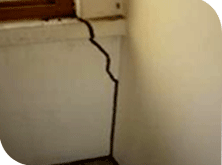
Mub Tubes
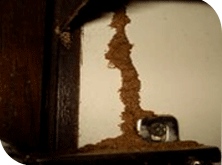
Termite Swarmers

Wood Damage
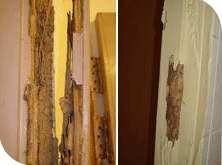
Termites Frass

Termite Mound

Termite Control Treatments
Pre-constructional Anti-termite Treatment
- CHEMICAL:- Will be using pesticide BIFLEX TC
- SCOPE OF WORK :- To create an effective chemical barrier beneath & around the building to prevent any subterranean termite infestation. Unlike other form of pest control where the eradication of the nest or the treatment of the pest are the major objectives, the basis for success in subterranean termite control is to eliminate the insects source of food and water. This can only be achieved by the establishment of the chemical barrier, through which the termite cannot pass & survive. This is obtained by treating the soil underneath and around the building with a residual chemical.
- TREATMENT METHOD :- The diluted chemical emulsion will be sprayed into the finished rammed backfill area before laying slab on grade to soak the soil with the residual chemical to create an effective horizontal chemical barrier beneath the floor. An additional vertical treatment will be made on the sides of foundation wall to prevent any subterranean attack.
- RATE & CONCENTRATION :- For the above treatment, the specified chemical is BIFLEX TC technical concentrate to be applied at 0.8% concentration. Rate of application for the under floor slab area is 4 to 5 liters per M2 of the surface area and 5 to 6 liters per running meter.
- SOIL CONDITION :- The soil should be dry and should act as an absorbent during the treatment. In the event of water logging of foundation, the water shall be pumped out and the chemical emulsion applied when soil is dry.
- DISTURBANCE:- Once formed, treated soil barrier shall not be disturbed, as it will break the continuity and completeness of the barrier system.
- SAFETY:- The Chemical used for the treatment is insecticides with a persistent action and is regarded as “Poison” this chemical can have an adverse effect upon health when absorbed through the skin, inhaled as vapours or spray mist or swallowed. So it is important to take safety precautions at treatment site to avoid any delay in construction work. Chemical treatment can be scheduled for any convenient time when the site is free.
Post-constructional Anti-termite Treatment
- SCOPE OF WORK :- To create an effective chemical barrier beneath & around to prevent any subterranean termite infestation. Unlike other form of pest control where the eradication of the nest or the treatment of the pest are the major objectives, the basis for success in subterranean termite control is to eliminate the insects source of food and water. This can only be achieved by the establishment of the chemical barrier, through which the termite cannot pass & survive. This is obtained by treating the soil underneath and around the building with a residual chemical like bifenthrin.
- TREATMENT METHOD :- The post construction treatment will be made by drilling interior area by drill machine and each hole will be 12-19 mm, 30 cms far from the other and inject in the hole dilution of bifenthrin like BIFLEX TC concentration. Every running meter will be saturated by the diluted pesticides and ratio of 6 litres.

